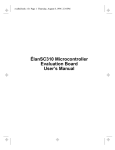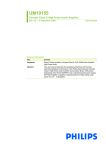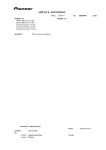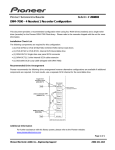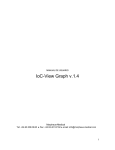Download MCC MIIC-203 User guide
Transcript
NEW Product ATC210 Dual Input Bus Converter EVALUATION BOARD User Guide 207 1. Introduction 2 2. Evaluation Board Functionality A_OK# and B_OK# LEDs 2 Converter Voltage LED 2 Clamp Voltage LED 2 Volt LED 2 3.3 Vout Margin Switch 2 Margin Switch Setting 2 12 V O/P Enable Switch 2 12 V LED 2 INTRPT LED 2 3. Connecting Up and interfacing the I2C Bus 207 Rev. 01 / 16 August 2006 File Name: an_atc210_evalbd.pdf 2 ATC210 Evaluation Board | User Guide 207 1. Introduction The ATC210 Evaluation Board is designed to demonstrate the many capabilities of Artesyn’s ATC210 converter. The ATC210 converter is a high density, dual-input, dual-output, 210 W Bus Converter designed to meet the requirements of the PICMG 3.0 Advanced TCA Base Specification telecommunication standard. This converter is designed to greatly simplify the power input requirements of the ATCA system boards by integrating all the necessary components (except hold-up capacitors) while operating on either of two isolated -48 Volt power inputs and providing two low voltage (12 V and 3.3 V) power outputs. Internally the ATCA converter contains, isolated ORing diodes, a hot swap controller, a 41.5 V hold-up voltage clamp to allow the use of small 50 V hold-up capacitors, an input conducted EMI filter, highly efficient 12 Vdc and 3.3 Vdc converters, a separate 12 V output switch, and a microcontroller based I2C interface circuit. The ATC210 converter offers a wide input voltage range of –36 Vdc to -72 Vdc and can operate over an ambient temperature range of -25 °C to +85 °C. Ultra-high efficiency operation is achieved through the use of proprietary synchronous rectification and control techniques. The module is fully protected against overcurrent, overvoltage and overtemperature conditions. Standard features include isolated remote ON/OFF, A_OK and B_OK power-good indicators simplified 3.3 V margining, and I2C power and temperature monitoring. 2. Evaluation Board Functionality The evaluation board will function when an ATC210 converter is either soldered or connected through pin sockets (jacks) to the Evaluation Board, a voltage between -36 Vdc to –72 Vdc (valid voltage) is applied to either –48V_A and RTN_A (“A” inputs), -48V_B and RTN_B (“B” inputs), and both Enable_A and Enable_B are switched on. 2.1 A_OK# and B_OK# LEDs When Enable_A and Enable_B are switched on and a valid voltage is applied to the “A” inputs, the A_OK# LED will light and likewise when a valid voltage is applied to the ”B” inputs, B_OK# LED will light. When a valid voltage is applied to both inputs, both LEDs will light. In practice, the enable pins are the last to make contact. When they do make contact, they connect to their respective Returns, and are effectively the ‘green light’ for the ATCA power converter to start-up. So, with both enables switched to the ‘on’ position, and with either or both input feeds connected, the unit turns on. 2.2 Converter Voltage LED The Converter Voltage LED will light when power is available to the internal IBC -48 Vdc to 12 Vdc converter. 2.3 Clamp Voltage LED When the input voltage on the hold-up capacitors rises to above 41 volts approximately, the Clamp Voltage LED will light to indicate that the 50 V hold-up capacitors are charged to the minimum requirement, to give a 5 ms hold-up time at maximum output load of 210 Watts. 2.4 3.3 Volt LED The 3.3 V output LED will light when 3.3 V power is available at the 3.3 V output terminals. The 3.3 V output LED will not light if the 3.3 V output voltage is less than 3.0 Volts. The 3.3 V output can drive up to a maximum load of 1.8 A. 2 File Name: an_atc210_evalbd.pdf Rev: 16 Aug 2006 2.5 3.3 Vout Margin Switch Once the 3.3 V power is available, the 3.3 V output voltage can be increased or decreased by approximately 5% by switching the margin switch either HIGH or LOW. 2.5.1 Margin Switch Setting • High 3.3 V output = 3.47 V 3.3 V output = 3.32 V • Normal • Low 3.3 V output = 3.16 V 2.6 12 V O/P Enable Switch This switch is effectively the remote control input. It is referenced to the secondary side, and uses the 3.3 V output to enable/disable the 12 V output. 2.7 12 V LED The 12 V output LED will light when the 12 V is switched ON and power is available at the 12 V output terminals. The 12 V output LED will not light if the 12 V output voltage is less than 11.3 V. The 12 V output can drive up to a maximum load of 17.5 A including the 1 W on board fan. The 12 V fan will operate when 12 V is available on the 12 V output. The fan can also be powered by an external 12 V supply. 2.8 Interrupt LED This LED will light whenever the interrupt line is active low. An interrupt occurs whenever an internal parameter limit is violated. The limits can be changed from the default values via the I2C bus. 3. Connecting Up and Interfacing the I2C Bus This section describes in detail how to connect and install the software. The following list of items are supplied: • Evaluation Board with ATC210 converter attached • iPort/AFM RS-232 to I2C Bus Host Adaptor • I2C Interface Cable • RS-232 Serial Port Cable, 9F/25M • Mains Power Supply 1. Download the ATC210 Evaluation Board Interface Program from the Artesyn web site via the following link: http://www.artesyn.com/registration/resource/ResourceProvi der?target=/media/pdfs/atc210_sw_download.zip 2. Install the downloaded ATC210, there may be a need to load Microsoft’s .Net Framework version 1.1. This software is available via the following link: http://www.microsoft.com/downloads/details.aspx?FamilyID =262d25e3-f589-4842-8157-034d1e7cf3a3&displaylang=en 3. Connect the RS-232 cable between the iPort and the serial port of the PC. If there is more than one serial port, the Interface Program will connect automatically. The ‘pull-ups’ switch on the iPort must be left in the default ‘off’ position when operating with this Evaluation board. The iPort is manufactured by MCC, p/n MIIC-203G, www.mcc-us.com. 4. Connect the I2C Interface Cable between the Evaluation board and the iPort. 5. Plug the 5 V power supply into the ac outlet using the appropriate Adaptor. Connect the other end to the iPort. 6. Double click on the ATC210 I2C icon that is on the desktop to start the program. User Guide 207 7. Power up the Evaluation Board. Make sure that both ENABLE switches are in the ‘on’ position, and that the 12 V O/P switch is also ‘on’. Operational voltage is between -36 Vdc and -72 Vdc. Input voltage should not exceed 75 V. 8. Once powered up, the I2C communications can be initiated by clicking on the ‘Connect II2’ button in the Interface Program. A successful connection will indicate ‘iPort/AFM Found’ and ‘ATCA Responding’ in the message box on the top right hand side. Once the I2C communication has been established, the register values and parameter values are read once and appear on the interface. Reading or writing functions can be performed manually or automatically. For more information on using the ATC210 Evaluation Board Interface Program click on Help. 12V_OUT FAN SUPPLY EXT SUPPLY S E12 E11 J22 J21 INT SUPPLY 1 2 1 2 S C4 1200UF 16V 20% C3 1200UF 16V 20% C5 1200UF 16V 20% C6 1200UF 16V 20% -48V_A E1 + FAN + + -48V_B E2 E14 E13 BNC2 C1 1UF 25V 10% RTN_B E5 SW1 1 J6 -48V_A 1 J8 -48V_B 1 J9 EARLY_A 1 J10 EARLY_B 1 J11 RTN_A 1 J12 RTN_B 1 J19 ENA 1 J20 ENB 2 3 XXX SW2 1 2 3 HU+OUT XXX D2 PDZ12B XXX S S C_CL- S R1 20K 1% .25W CR2 XXX XXX 12V_RTN J5 1 1 J14 HU- D1 C10 C11 C12 C9 C8 1000UF 1000UF 1000UF 1000UF 1000UF 50V 50V 50V 50V 50V 20% 20% 20% 20% 20% + + + + R4 + 100K 1% .125W A2 S S R3 15K 1% .25W R2 15K 1% .25W A1 S MMBD1404A 175V CR3 XXX XXX C15 82UF 63V 20% 1 J16 ON/OFF1 J17 ON/OFF+ S BSS63 C 12V_OUT J4 1 1 J13 C_CL- E B R5 60.4 kΩ 1% .125W ATCA 210W HU- C_CL- 1 J7 HU+OUT 1 J15 HU+IN S R6 27.4 kΩ 1% .125W Q4 SW3 R2 5% .5W HU+OUT 3 3.3V_RTN 12V_RTN C14 S C2 + 10UF 1UF 25V 25V 10% S 10% R13 10K 1% Q1 E .125W B S S S C R12 R16 10K BSS63 S R15 13.3K 1% 681 1% .125W 1% .125W VR2 .125W AQT431 S R14 CR6 C16 XXX 1000UF 10K XXX 1% 16V 20% .125W S SDA S SW4 3.3 V O/P Adjust 1 2 OFF 3 XXX J18 1 2 3 4 5 6 7 8 9 10 11 12 13 14 3V3_RTN 2 B_OK# S S DEVICE=CON-MATE-14 R27 N/A S USB to SMBus U5 DEL-COM IC C23 10UF 10V 10% S S C24 100PF 100V 10% P04 P00 P01 P05 P02 P06 P03 P07 P10 P11 P13 P12 D+ VSS DVPP VCC CEXT XTAL_OUT XTAL_IN Y1 6 MHZ S R26 N/A S R28 N/A 3V3_RTN R29 N/A INTRPT CR1 XXX XXX R11 681 1% .125W S 20 19 18 17 16 15 14 13 12 11 3V3_OUT SCL NOT ASSEMBLED S CR7 XXX XXX VR1 AQT431 R7 10K 1% .125W S BNC4 C13 10UF 25V 10% S S J1 1 2 3 4 C R25 681 1% .125W BNC3 XXX E16 .1W 1% 7.5K R40 BSS63 R31 10K 1% .125W 1 SW3 12 V R/C HU- USB S 3.3V_OUT Q5 E B S BNC1 RTN_A E6 S S C7 1200UF 16V 20% R10 80.6K 1% .125W R34 10K 1% .125W S R33 1K 1% .1W 2 3 4 5 6 7 8 9 10 R32 1K 1% .1W U1 PCA9515 8 Vcc 3 SDA0 SDA1 6 2 SCL0 SCL1 7 5 EN NC 1 GND S R24 1K 1% .1W S R17 10K 1% Q2 E .125W B S R35 1K S 1% .125W S R36 1K 1% .125W SDA CR5 XXX XXX 3V3_RTN SDA SCL I C BUS REPEATER 3V3_RTN R19 10K 1% .125W Q3 E B SCL S R20 BSS63 C 10K S R22 1% 681 .125W 1% .125W B_OK# S C R18 BSS63 10K S R21 1% 681 .125W 1% .125W A_OK# CR4 XXX XXX R30 1K 1% .1W 3V3_RTN S R8 S I2C CONNECTOR SCL SDA N/A 1 J2 2 3 4 4-PIN HEADER SCL SDA INTRPT 1 J3 2 3 4 S R9 N/A 3V3_RTN 3V3_RTN 3V3_RTN Figure 1: Evaluation Board Schematic File Name: an_atc210_evalbd.pdf Rev: 16 Aug 2006 www.artesyn.com 3 ATC210 Evaluation Board | User Guide 207 Figure 2: Photograph of the Evaluation Board ATC210W EVALUATION BOARD Ext Supply Enable_A OFF Cooling Fan Int 12 V - + ON Airflow Direction Enable_B + + OFF + + C4 C5 + ON UUT J6 J9 -48 V_A C1 C13 J8 TP2 J10 R7 R10 TP1 12 Vout C7 C3 RTN_A C6 BNC1 12 Vout BNC2 VR1 J11 R25 J12 J19 J20 J14 J7 J15 J16 J17 TP4 Q4 R1 ON C10 +353 24 93130 +1 800 769 7272 +852 2699 2868 R13 R12 VR2 C16 R14 R21 R27 3.3 Vout R5 R32 TP6 CR4 CR5 A_OK B_OK 3V3_RTN INTRPT SDA SCL Y1 CR1 INTERRUPT J1 [email protected] [email protected] [email protected] Figure 3: Evaluation Board Layout File Name: an_atc210_evalbd.pdf Rev: 16 Aug 2006 U5 R40 3.3 V RTN R33 C24 R24 R30 R9 CR3 CR2 C23 TP5 U1 WEBSITE www.artesyn.com 4 R16 BNC4 Q3 USB EUROPE NORTH AMERICA ASIA Q1 + BNC3 NC SDA GND + C9 + 3.3 V R15 Low Off High SCL C11 OFF 12 V O/P C2 3.3 Vout R22 TP7 CLAMP CONVERTER VOLTAGE VOLTAGE + R18 R17 R19 R20 R4 R2 C12 C8 R11 Q2 SW3 Q1 R3 R23 + C15 R5 R6 D2 C14 R26 R36 R28 R35 R29 J13 TP3 -48 V_B 12 V RTN SW4 J18 RTN_B 12 V 3.3 V Trim 12C




